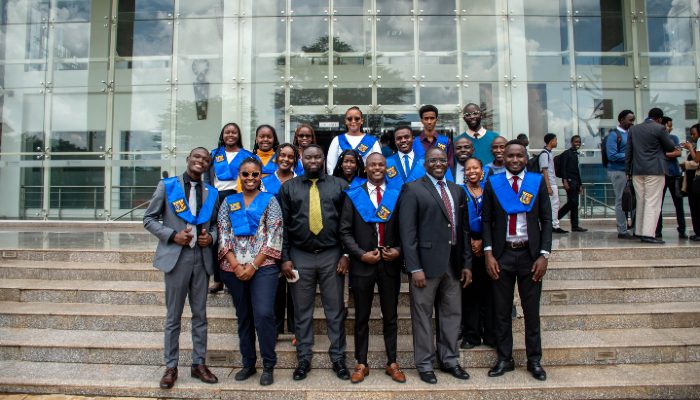A team of four authors from Strathmore University collaborated to write a chapter in the recently launched book, The Bloomsbury Handbook of Student Voice in Higher Education. The authors include Paul Ochieng, the Dean of Students; Vianney Sebayiga and Christine Njane, both graduates of Strathmore Law School’s Class of 2021 and now Advocates of the High Court; and Dr. Alfred Kitawi, the Director of the Centre for Research in Education and a Lecturer at the University.
The book brings together experienced scholars from various subfields and geopolitical contexts to understand how the students’ voice operates in different higher education contexts around the world. The book identifies the common core elements, the enabling conditions, constraints and outcomes that are associated with student voice work in the global higher education space.
Generally, student voice is used to signify students’ active involvement in an effort to influence educational decision making at the classroom, programme, institution or systems level. As captured in the introduction, the publication aims to illustrate various forms of student voice, including student activism, student representation and governance, and pedagogical partnership. Secondly, the book aims to show how these and other forms of student voice are playing out within the ever-changing higher education landscape today.

While the literature on student voice in the secondary education context is well-established (albeit largely in Western countries, with predominantly northern voices), the terminology of student voice has been slower to catch on within higher education, especially within the southern context. Therefore, it was a great milestone for Strathmore University authors to be part of the publication as they have brought to the fore what student voice can mean within Sub-Saharan Africa.
The contributors to the book are well established and respected in the global higher education space. The book has been divided into five sections:
Section I. Theorizing Student Voice
Section II. Hearing the Voices of Diverse Student Populations
Section III. Amplifying Student Voice through Activism, Community Service and Digital Civic Engagement
Section IV. Institutionalizing Student Voice through Governance Structures
Section V. Elevating Student Voice through Pedagogical Partnerships
The Strathmore authors’ chapter is in section four, and it is titled Enabling Students’ Voices in a Developing Country Context: Challenges and Opportunities. The authors talk about institutionalizing student voice in a complex and dynamic institution with multiple agencies. They also discuss the criticality of the student voice in the functioning of Strathmore University, especially during the Covid-19 pandemic. The contribution is worthwhile as it demonstrates how emerging universities can critically claim their space in elucidating the importance of students’ voice.
The handbook has a global scale and character, demonstrated by the contributions from a wide range of global authors. It can be read cover to cover or in sections. It opens new horizons for university administrators, gives new ideas to researchers in student management and makes a big contribution to the literature on student voice.
Happy reading and kudos to the team!
You can read the book here or get a copy from the University Main Library.
What’s your story? We’d like to hear it. Contact us via communications@strathmore.edu
ALSO CHECK OUT
See more news-

Gen Francis Ogolla: How power of humility delivers transformative leadership* 25,Apr,2024
As the country mourns the Chief of Defence Forces of Kenya, General
-

Highlights from the SBS Undergraduate Fourth Years’ Gala Dinner* 25,Apr,2024
Friday, 8th March 2024 was an evening of celebration as students from the
-

Celebrating Humanities and Social Sciences 2024 graduates.* 25,Apr,2024
On Friday evening, April 19th 2024, Strathmore University held a celebratory gala
-

Elevating Tourism & Hospitality Leadership: Transformative trends shaping the future of the industry* 23,Apr,2024
On April 18, 2024, the Strathmore University School of Tourism and Hospitality
-

Towards Climate Resilience: Strathmore University, Imperial College Partnership* 23,Apr,2024
In a bid to foster joint efforts in tackling climate resilience issues,
-

Crossing Continents: Yvette Yego’s Transformative Journey through the Sciences Po Exchange Program* 22,Apr,2024
“I’ve gained extensive knowledge in international studies, interacted with diverse students from
-

Stratizens Explore Malaysian Cinema: Mechamato Screening at Sarit Center* 22,Apr,2024
Imagine being invited by the Malaysian embassy in Kenya to an exclusive
-

Strathmore Hosts the 2nd Mediation Summit on Employment Disputes* 19,Apr,2024
In a world where the dynamics of employment relations shape the very
-

Strathmore Tax Hackathon 2024: Cultivating Innovation in Tax Policy* 19,Apr,2024
In the heart of Nairobi, the prestigious Strathmore Law School hosted the
-

Transforming Mental Health Support for Students at Strathmore* 17,Apr,2024
In Kenya, within the bustling academic environment of universities, there exists a

